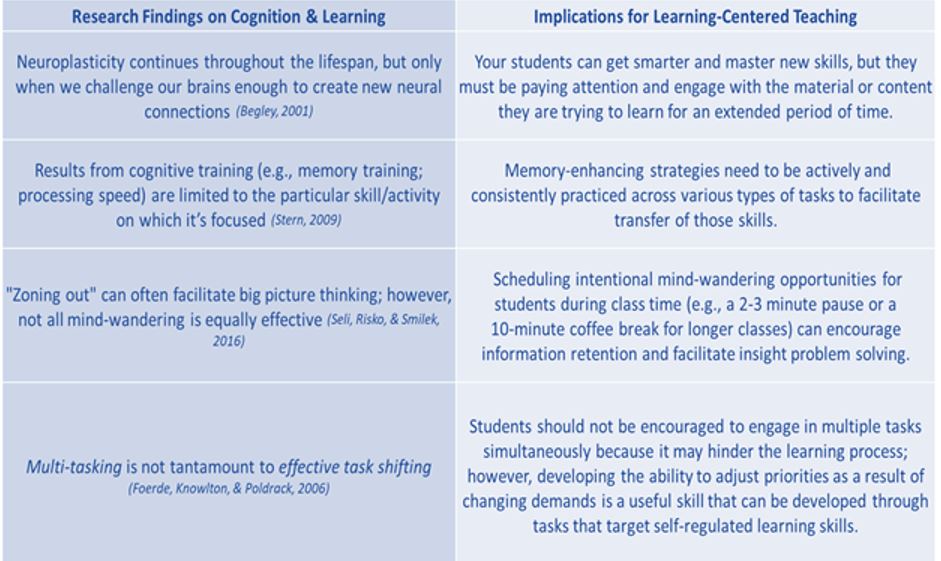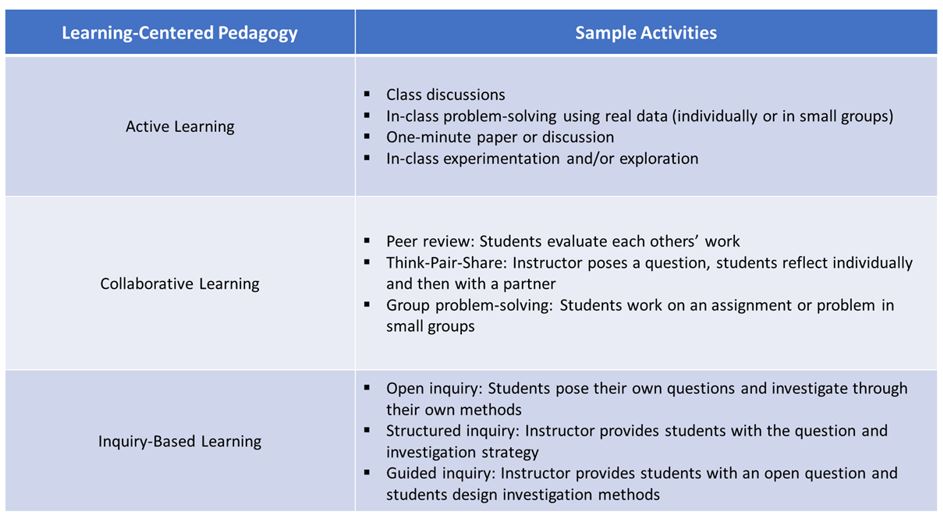Inclusive Teaching
- Why do we care about inclusive Teaching?
At FIU, we strive to ensure that every student feels welcomed and valued as a member of the Panther community. It is our belief that through inclusive teaching, our faculty can create learning environments that leverage diversity, student backgrounds, and lived experiences, as resources for learning and success (Ginsberg & Wlodkowski, 1995; 2009; Hammond, 2015).
- FIU's Model of Inclusive Teaching
Although there are several theoretical models from which to draw from in this area, FIU primarily relies on Ginsberg & Wlodkowski's (1995) framework for culturally responsive teaching to guide our philosophy and programming on inclusive teaching. Ginsberg & Wlodkowski's framework—which is heavily influenced by psychological theories in motivation and engagement—is characterized by four individual but connected components: establishing inclusion; developing attitude; enhancing meaning; and engendering competence.
Establishing Inclusion: Creating a learning environment in which learners feel capable, respected, accepted, and connected to one another.
- Guidelines for respectful learning and interactions
- All students feel comfortable asking questions like their ideas are valued, and like they are treated with respect
- Students’ lives and cultures are represented
- Emphasis on awareness and feeling of connection
Developing Attitude: Creating a favorable disposition toward the learning experience through personal relevance and choice.
- Classes are taught with students’ experiences, concerns, or interests in mind
- Students make choices related to learning that include experiences, values, needs, and strengths
- Students are able to voice their opinions
Enhancing Meaning: Creating challenging learning experiences that include learners' values and perspectives, past experiences, emotions, goals, and an awareness that their state of mind influences the learning process.
- Student participation is active; they are challenged
- Questions go beyond facts and encourage different points of view
- The teacher builds on what students already know
- The teacher respectfully encourages high-quality responses
Engendering Competence: Recognizing the varied ways in which students can perceive meaning and authenticity, then developing assessments that account for these differences.
- There are clear criteria for success
- Grading policies are fair to all
- Assessments take into account students’ perspectives
- There are multiple ways to reach standards/demonstrate learning
- Inclusive Teaching in the Classroom
Incorporating inclusive teaching does not require a comprehensive change to course design or content. In fact, inclusive teaching practices can be easily embedded into existing course structures.
Class Discussions:
- Ask students to take turns speaking
- Consistently invite every member of the class to participate
- Attempt to activate students’ relevant background knowledge
- Make corrections by mirroring correct form
Lecturing:
- Start lecture with a brief overview of main points covered in the previous class session
- Give your students tips on effective note taking
- Encourage native English speaking students to provide their notes to ESL students
- Collect notes occasionally and provide students with feedback
- Allow students to compare notes in small groups
Cooperative Learning (i.e., group work):
- Start lecture with a brief overview of main points covered in the previous class session
- Give your students tips on effective note taking
- Encourage native English speaking students to provide their notes to ESL students
- Collect notes occasionally and provide students with feedback
- Allow students to compare notes in small groups
Course Goals & Objectives:
- Develop clearly defined learning goals and provide a rationale for each goal
- Identify resources that might help your students as they work towards those goals
Assessment:
- Provide students with some degree of choice in assessment methods
- Develop clear instructions and questions
- Ask students for feedback on the clarity of assessment tools
Evidenced-Based
- Why is evidenced-based teaching important?As a research-focused institution and because of the importance of our students' success at FIU, it is imperative that the teaching that takes place at our institution aligns with best practices in the educational literature. As a result, here at CAT, all of our workshops focus on encouraging teaching strategies that are not only inclusive and learning-centered, but that have also been found to be effective practices based on research findings.
- Collecting and Using Internal Evidence
Collecting & Using Internal Evidence
We often teach without knowing which aspects of our teaching are most effective and/or how to identify and improve those aspects that could use refinement. However, by collecting data on student learning and performance in our classroom, we can inform course enhancement and allow for more targeted refinements. We can also draw from existing research to identify instructional strategies that can help address specific challenges in our classroom, then collect data from students to examine the effectiveness of those strategies.
- Curating and Using External Evidence
Curating and Using External Evidence
Informed by the scholarship of teaching and learning, faculty can make better decisions about their instructional design and practices. To begin the process of using external evidence for decision making in teaching, Blumberg (2011) suggests reading pedagogical literature in your own discipline or broadly across other disciplines and consulting with teaching and learning experts. At CAT, we take a consultative approach where we can help you interpret your data and identify appropriate EBT practices. We can also direct you to DBER faculty at FIU who have expert knowledge of and/or experience using research-validated strategies.
- Examples of Evidence-Based Practices and How They Benefit Students
Examples of evidence-based practices and how they benefit students
State clear learning goals repeatedly:
- Encourages students to set their own goals
- Created transparency in the classroom
- Helps students understand the rationale for course content and tasks
Provide high-quality feedback on low stakes assignments often:
- Allows students to incorporate feedback for subsequent higher-stakes assignments (e.g., final exams, capstone papers)
- Facilitates the development of students metacognitive skills
- Can be used to provide a model for students to learn to evaluate their own work
Provide opportunities for repeated and spaced practice:
- Repeated practice facilitates the incorporation of information from working memory to long term memory
- Spaced practice facilitates the transfer of knowledge
Encourage and facilitate peer to peer learning:
- Well-designed group work can help students become effective collaborators
- Group work can promote a sense of belonging and community in the classroom
- Helps students develop a sense of accountability and learn how to hold others accountable
Promote effective self-regulated learning skills:
- SRL skills are associated with higher course grades
- Students with better SRL skills are more engaged and more likely to seek out challenging learning opportunities
- Becoming effective learners will benefit students both in and outside of your classroom
Learning-Centered Teaching
- Why do we care about learning-centered teaching?A general consensus across findings from research on cognition and learning is that the one who does the work, does the learning. Thus in an effective learning environment, students do the bulk of the cognitive work while the instructor functions as facilitator. Learning-Centered Teaching (LCT) practices refer to instructional techniques that seek to enhance student learning by encouraging greater cognitive engagement and participation during the learning process.
- The Research on Teaching and Learning
Findings from decades of research on memory and cognition have uncovered valuable insights with important and direct implications for teaching and learning. Becoming familiar with some of these findings can help instructors design their course(s) in a way that facilitates and maximizes student learning and motivation.
Brief summaries of important findings from research on learning and their implications for LCT.

- Learning-Centered Teaching in the Classroom
What does LCT look like in the classroom?
LCT relies on instructional methods that are based on documented cognitive research on how learning takes place, including (but not limited to):
- Active learning, in which students solve problems, answer questions, formulate questions of their own, discuss, explain, debate, or brainstorm during class with faculty serving as expert when the need arises.
- Collaborative learning, in which students engage in group work with peers on assignments and projects that include structures and scaffolds to ensure both positive interdependence and individual accountability.
- Inquiry-based learning, in which students are first presented with challenges or questions to which they are expected to solve or seek answers.
These instructional methods provide a framework for pedagogical design and can be tailored to specific domains/topics. Examples of active learning, collaborative learning, and inquiry-based learning.
